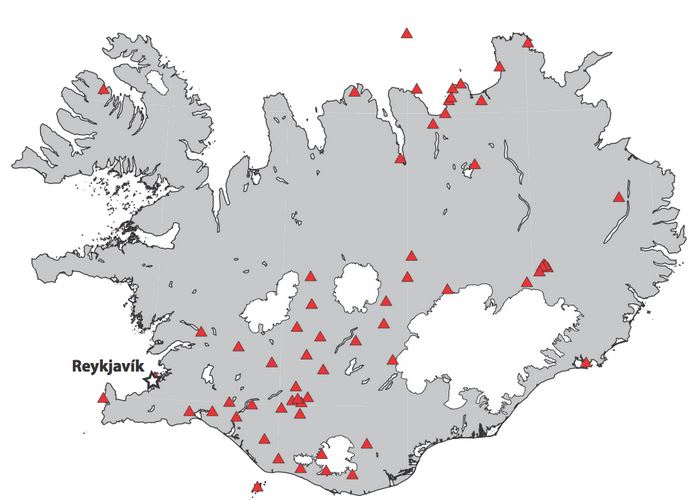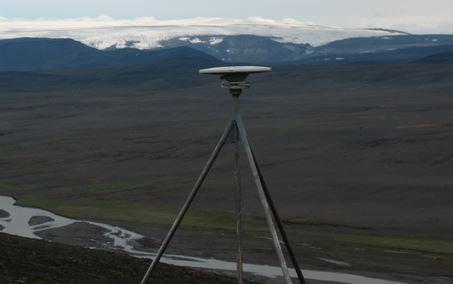Iceland’s land is rising, by 1.4 inches each year in many parts of the country, as glaciers melt and the crust below and nearby rebounds, researchers from the University of Arizona and the University of Iceland reported in a new study.
In other words, as glaciers melt there is less weight pushing down on the land, which subsequently rises.
The geoscientists warned that volcanic activity is likely to increase as it did during the last deglaciation roughly 12,000 years ago.
Their study has been published in the academic journal Geophysical Research Letter (citation below).

The geoscientists used Iceland’s geodesy network of sensitive GPS receivers (red triangles) to determine how fast the land is rising. (Credit: Kathleen Compton/UA Department of Geosciences. Image: University of Arizona)
The team members say their study is the first to show the current rapid uplift of the Icelandic crust resulting from the accelerated melting of the country’s glaciers and coincides with the current global warming that started about 30 years ago.
The researchers were surprised to find that some sites in south-central Iceland are rising by up to 1.4 inches annually.
First author, Kathleen Compton, a geosciences doctoral candidate at the University of Arizona, said:
“Our research makes the connection between recent accelerated uplift and the accelerated melting of the Icelandic ice caps.”
Scientists have long known that the Earth rebounds as glaciers melt and become lighter. Whether the current rise in land level geologists detect is linked to past deglaciation or modern ice loss has been open to question until now, UA associate professor of geosciences Richard Bennet explained.
Co-author Mr. Bennett said:
“Iceland is the first place we can say accelerated uplift means accelerated ice mass loss.”
Positioning satellite receivers used
To determine how rapidly the crust was rising, the researchers used a network of 62 global positioning satellite receivers that had been fastened to rocks across the country. By tracking the position of the GPS receivers over several years, the geoscientists “watched” the rocks move and were able to calculate how far they had traveled. This technique is called geodesy.
The study demonstrated that, at least for Iceland, the land’s current accelerating uplift is directly associated with the thinning of glaciers and to global warming, the authors wrote.
Mr. Bennett said:
“What we’re observing is a climatically induced change in the Earth’s surface.”
Approximately 12,000 years ago, during the last deglaciation, there is evidence that volcanic activity in some regions of the island increased thirty-fold, Mr. Bennet added.
Other scientists have calculated that as Iceland’s crust rebounds from warming-induced ice loss, the frequency of volcanic eruptions, such as the eruption of Eyjafjallajökull in 2010, which had negative economic consequences globally, is going to increase.

One of the 62 global positioning satellite receivers, part of Iceland’s network that geoscientists are using to detect movement of the crust. (Photo: Richard A. Bennett/UA Department of Geosciences)
Some of the GPS receivers had been in place in Iceland since 1995. Mr. Bennett and Sigrun Hreinsdóttir of GNS Science in Avalon, New Zealand, had installed 20 GPS receivers in Iceland in 2006 and 2009, thus enhancing the coverage of the country’s geodesy network.
In southern and central Iceland, where five of the biggest ice caps are located, the receivers are up to 18 miles apart.
The researchers primarily used the geodesy network to track geological activity, such as volcanic eruptions and earthquakes.
Mr. Bennett noticed in 2013 that one of the long-standing stations in the center of Iceland was showing that the site was rising at an accelerated rate. The team checked the nearby stations to determine whether any changes had been recorded elsewhere.
Mr. Bennett said:
“The striking answer was, yes, they all do. We wondered what in the world could be causing this?”
They started to systematically analyze years of signals from the entire network and found that the fastest rate of uplift was occurring in the region between several large ice caps. The farther the receiver was from the ice cap region, the slower the rate of uplift, the data showed.
Land uplift caused by accelerated melting of glaciers
Other scientists who had been measuring ice loss in the island observed a notable acceleration in the rate of melting since 1995. According to Iceland’s records, some of which date back to the 1800s, temperatures have been increasing since 1980.
Ms. Compton used mathematical models to determine whether the same rate of ice loss year after year could cause such an acceleration in uplift. The answer was “no”. For more and more uplift to occur, the glaciers had to be melting at an accelerating rate each year.
Ms. Compton found that the loss of ice and the onset of rising temperatures corresponded tightly with her estimates of when uplift started.
Ms. Compton said “I was surprised how well everything lined up.”
Mr. Bennet added “There’s no way to explain that accelerated uplift unless the glacier is disappearing at an accelerated rate … Our hope is we can use current GPS measurements of uplift to more easily quantify ice loss.”
The geoscientists plan to analyze the uplift data to reveal seasonal variation, as ice caps melt during the summer and grow during the winter snow season.
Citation: “Climate driven vertical acceleration of Icelandic crust measured by CGPS geodesy,” Kathleen Compton, Richard A. Bennett and Sigrun Hreinsdóttir. Geophysical Research Letters. DOI: 10.1002/2014GL062446.

